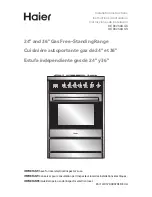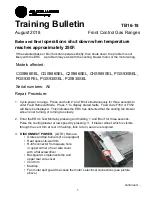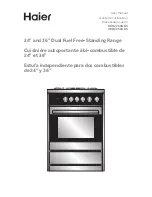
32
Problem
Possible Cause
What to do
Baked products
taking too long
to cook
Shelf position too low
Move shelf position up by one.
Temperature too low
Raise the temperature.
Shiny trays/tins being used
The material from which a baking pan is
made influences how fast the contents
of the pan are heated.
Although metals are good conductors a
container made of bright shiny metal is
a disadvantage when the transmission
of radiant energy is involved because it
tends to reflect the heat back into the
oven.
Use dark, dull baking tins and pans:
they absorb heat quicker and speed
up the cooking process. Also darker
tins promote browning where as shiny
tins reflect heat back into the oven
prolonging browning and increasing
cooking times.
Baking tin too large
Use the tin size stipulated in the recipe.
Baking time varies not only with oven
temperature and baking tin material; it
is also affected by tin size.
Incorrect function eg
CLASSIC BAKE
Try changing to a fan function. Fan
ovens speed up cooking and distribute
heat more evenly; they also increase
the rate of browning. Using a fan to
cook a sponge can take 3-5 minutes off
in comparison with a sponge cooked
using the Bake function.
Cake has fallen in
the centre
Baking temperature too
low
Raise the temperature.
Opening the door too
early in baking
Do not open the door until at least
3/4 of the cooking time has passed: a
sudden burst of cold air can make cakes
sink in the middle.
Baking time too short
Increase cooking time.
Proportions of ingredients
incorrect
Check recipe.
Clock reads ‘help’
Excessive voltage detected
- Safety Mode activated
Turn the range off at the wall, check
the mains connection and turn the
oven back on again to reset the clock
module. Reset the clock with the
correct time of day (see ‘Setting clocks
and times’).







































